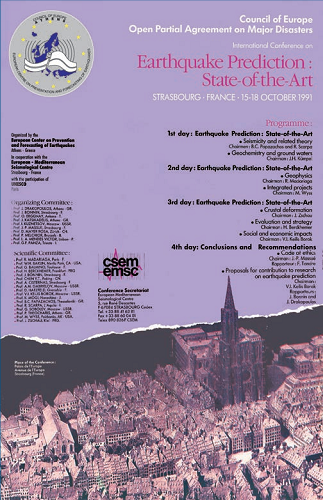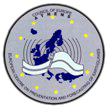Earthquake prediction: State of the art
Earthquake prediction: State of the art
In co-operation with the European-Mediterranean Seismological Centre of Strasbourg- France and participation of UNESCO.
The papers presented and the discussions that followed during the Conference clearly showed that earthquake prediction research is developing rapidly. We are still far from the goal of providing deterministic or high probability prediction in a limited time frame. It has been emphasised that scientists should not conceal negative prediction results, but rather be encouraged to present them in order to improve the overall understanding of the process of earthquake occurrence.
Nowadays, short-term predictions are associated with relatively low probabilities.
Geosciences have been able to reach higher confidence and probability levels in predicting earthquakes within a larger time period of years and decades.
It has become commonplace that the abilities to predict earthquakes could be further improved when based on observation, correlation and interpretation of a variety of different precursory phenomena. Data acquisition and correlation are facilitated if sensors for different precursors (such as seismicity variations, seismic anisotropy, various geophysical fields, ground deformation, ground water level variations, physical and chemical measurements in rocks and rock fluids), are recording simultaneously. Thus, the strategy of multidisciplinary earthquake prediction programme in test-sites is recommended in addition to global studies.
Some observations have to be performed with borehole instruments. Test-sites should be established to provide a focus for coordination, collaboration and mainly crosschecking results and methods, through a wide variety of disciplines.
Special emphasis should be given to the revolutionary increase in information density with respect to crustal deformation, which can be obtained with space-borne methods, through a wide variety of disciplines.
Strategies should be developed towards an effective combination of this high-density information of regional and global character, and of results from local terrestrial networks of multidisciplinary activities. It has also been pointed out that earthquake catalogues are essential for medium- and long-term prediction: this requires strengthening of collection, standardisation and quality assessment of parametric data. Although earthquake parameters are the most common data available, attention should also be paid to deformation, seismic sources, etc.
On the other hand, it becomes clear that predictions based on physico-mathematical models are promising; new approaches, for example in the probabilistic domain and in non-linear dynamics, are required. This applies in particular to identification of anomalies in seismicity patterns.
It was also demonstrated during the meeting, that further development of time-dependent seismicity models and related observations (especially when treated in the probabilistic way) can be of practical use.
A 606-page Volume of the Scientific - Technical Contributions of this International Conference was issued with the following table of contents:
- Seismicity and Theory
- Geochemistry and Ground Waters
- Geophysics
- Crustal Deformation
- Integrated Projects
- Evaluation and Strategy
- Social and Economic Impacts

ΚΑΝΕΠΕ - ΚΑΝΟΝΙΣΜΟΣ ΕΠΕΜΒΑΣΕΩΝ - CODE OF INTERVENTIONS
The Code of Interventions has been translated into English after harmonization with Eurocode 8 Part 3

